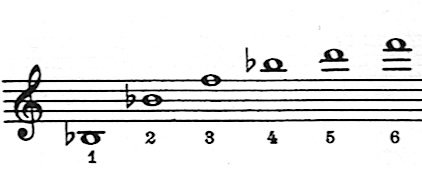An Introduction to Overtones, the Basis of Playing the Saxophone’s Altissimo!
Overtones are the natural occurring intervals that form a chord. Or as the dictionary puts it; “An overtone is any frequency higher than the fundamental frequency of a sound”. But we don’t have to get caught up in this scientific explanation, and I’ll lay it out here as it relates to your efforts in developing control of the saxophone’s altissimo range. To understand the overtone principle in a musical way that relates directly to us as musicians, and in this case as saxophone students, here is a diagram showing this natural overtone series:
Natural Overtone Series
The above 6 notes are the natural overtone series of a regular major chord. The names of these notes in this particular chord are low B flat, middle B flat, F, high B flat, D, F. This makes a very full B flat major chord. We can play a complete but less full major chord using only one Bb, D, and F notes which translate into 1, 3, 5. This is simple theory which many of you probably know already, if not you do now! Remember these notes and intervals (1, 3, 5).
Natural Overtone Series Slightly Extended
The above shows 2 more notes of the natural overtone series, numbered as 7 and 8 and are the A flat and yet another 3rd octave high B flat.
What Does All This Have To Do With Learning How To Play The Saxophone’s Altissimo?
The reason that we can play these altissimo notes on a saxophone is possible because of this scientific law known as overtones or “harmonics”. These overtones shown in the image above can be played by using a single fingering position on the saxophone. If you’ve never tried it this may sound crazy or even impossible but it’s true. This is how you are going to develop the specialized technique needed to play the altissimo range. The fingering at this point is very simple because as I just mentioned, is only one. The tricks that you are about to learn involve air and embouchure changes required to make these notes from one fingering position a reality.



